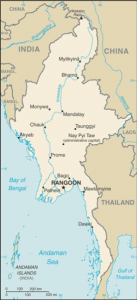In a follow-up to an earlier report on the cases of circulating vaccine-derived poliovirus in Myanmar, the World Health Organization published the following Monday concerning the details:

Laboratory confirmation that VDPV type 2 is circulating in Myanmar was received on 7 November 2015. The circulating VDPV2 was isolated from a 16-month old boy who developed acute flaccid paralysis (AFP) on 5 October. The child had not been previously vaccinated against polio. This strain is from the same VDPV2 strain isolated earlier this year from a polio case (a 28-month-old child) that had developed AFP on 16 April. The two cases are from the same township in Rakhine state. The genetic changes of the isolates detected in April and October suggest that the cVDPV2 may have been circulating for more than one year.
A detailed investigation has been undertaken in the area and stool samples from 28 household / community contacts of the AFP case have been collected and sent for laboratory investigation. Three additional AFP cases, detected in the area during the active case search, are currently under investigation.
National vaccination coverage is estimated to be 76% (WHO/UNICEF estimates, 2014). Vaccination coverage is lower among special risk populations. National surveillance indicator rates in Myanmar are good (2015 non-polio AFP rate: 1.8; 93% adequate stool collection percentage); however, subnational gaps persist.
The Ministry of Health, supported by WHO and partners of the Global Polio Eradication Initiative, is engaging in implementing an urgent outbreak response plan. From 5 to 7 December, a first response supplementary immunization activity (SIA) with trivalent oral polio vaccine (tOPV) was conducted in 15 townships targeting nearly 360,000 children under the age of five years. The Ministry of Health plans to conduct at least three more large-scale SIAs in Rakhine and neighboring provinces as well as other identified ‘high risk’ areas of the country, between now and the end of February 2016. The exact dates and extent of the SIAs are still being finalized. Following confirmation of the initial isolate in April, a local immunization response had been implemented.

Considering the globally synchronized withdrawal of type 2 OPV in April 2016 (through the switch from tOPV to bivalent OPV – bOPV), efforts are underway to ensure that transmission of any cVDPV2 is interrupted ahead of that date. Myanmar has developed a national switch plan which was endorsed by the Ministry of Health. The plan is to move from tOPV to bOPV on 29 April. Inactivated polio vaccine (IPV) was launched throughout the country on 3 December.
Active searches for additional AFP and other activities to enhance surveillance for polioviruses are being intensified to more clearly ascertain the extent of circulation of this strain.
Surveillance and immunization activities are being strengthened in neighboring countries.
In addition, the US Centers for Disease Control and Prevention (CDC) issued a travel notice Monday for Myanmar, which states: CDC recommends that all travelers to Myanmar be fully vaccinated against polio. In addition, adults who have been fully vaccinated should receive a single lifetime booster dose of polio vaccine. (Inactivated polio vaccine [IPV] is used in the United States instead of OPV. IPV does not contain live virus, so it cannot cause vaccine-derived polio.)
Related:
- Polio in Russia, Tajikistan news stories false: WHO
- Laos reports 5th circulating vaccine-derived poliovirus case; unique challenges
- Zika virus and Chagas disease: Interviews with the experts


3 thoughts on “Myanmar polio update, CDC travel notice”